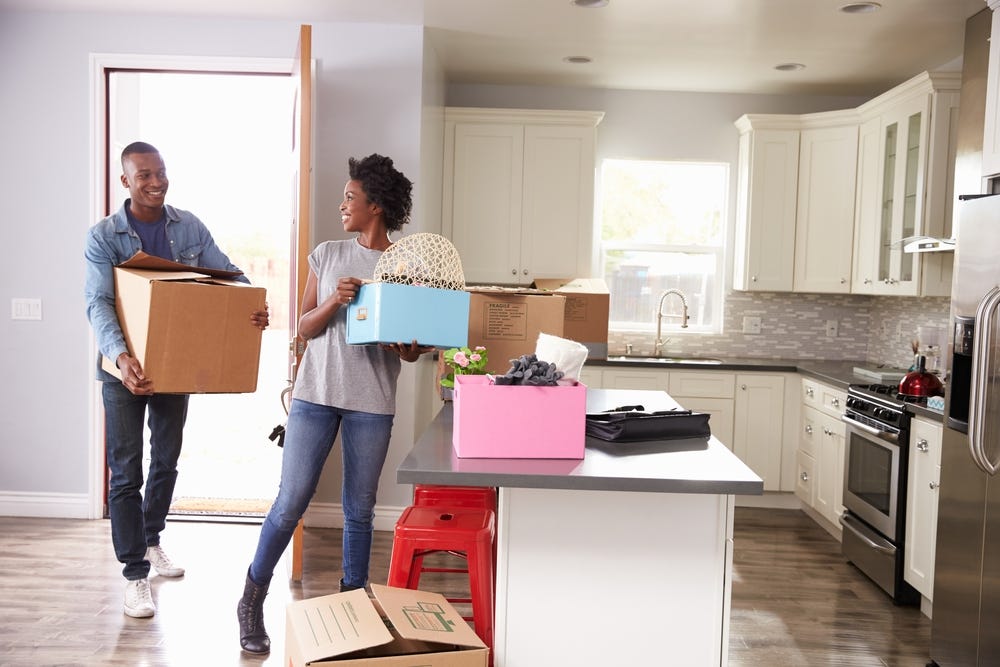Congrats! You’re moving into a new home. This time is exciting…and daunting. After all, there’s a lot to do. You need to complete repairs and projects on the new home, notify utility and billing companies about your new address, hire movers, and so much more.
And that’s all before move-in day!
We at Kin understand this and have put together this new home checklist to keep at your side. These are the top items every new homeowner needs to remember before, during, and after the big move.
1) Tackle your punch list
If you’re purchasing a newly constructed home, you should ask the home’s builder/contractor for a punch list - the list of problems that need to be fixed by the builder. Though reputable builders will have already done this, you should never assume.
Once the contractor has put together the punch list, they’ll flag the issues with red tape and have their workers address each one. Upon completion, the contractor should do another walkthrough to make sure all problems were fixed.
Ideal time to do: Before closing
Latest time to do: Before closing
2) Purchase home insurance
Though you probably had to apply for home insurance when applying for a mortgage, this step is important for all homeowners no matter their financial situation. Home insurance covers costs for a variety of events related to (or that occur on) your property.
Most home insurance policies include:
- Dwelling insurance: Coverage for damage to your home.
- Other structures insurance: Coverage for additional structures on your home, such as a shed or detached garage.
- Personal property insurance: Coverage for personal belongings.
- Loss of use insurance: Coverage for expenses incurred while you were displaced from your home.
- Personal liability insurance: Coverage for claims made against you due to events that happened on your property (e.g. injury).
- Medical payments insurance: Coverage for necessary medical expenses (i.e. smaller claims) due to an accident that happened on your property.
Homeowners should shop around and compare providers before settling on a home insurance policy. Different providers may qualify you for different discounts (e.g. new home, bundling with other products) which may lower your premiums and deductible.
Ideal time to do: Before closing (e.g. when getting a mortgage)
Latest time to do: Before move-in day
3) Get a home inspection
Ideally, you should have your home inspected by an independent professional before purchasing. The inspector can identify minor and major issues that you could leverage to save thousands on the home’s final price. Compared to the average inspection cost of $200-300, the potential savings are a bargain.
Ideal time to do: Before closing
Latest time to do: Before move-in day
4) Update mailing and billing information
Alright, now things are starting to sink in. Once you have a move-in date confirmed, you need to notify all major accounts of your change in address. These should include:
- Banks and credit card companies
- Employer
- Insurance companies
- Other accounts (e.g. student loan companies)
- Subscriptions (e.g. magazines, memberships)
- Utility companies
You should also set up mail forwarding at your post office to make sure you receive all mail over the first few months after the move. Monitoring the mail that gets forwarded will help you take stock of anything that slipped through the cracks.
Ideal time to do: Once you have a move-in date
Latest time to do: 1-2 weeks before move-in day
5) Set up services at your new home
For your new home, you need to contact utility and service providers to set up start dates. These include:
- Electric
- Gas
- Water
- Internet
- Cable
These dates don’t need to align with your move-in date but instead should be coordinated with when you plan to work on the home. For example, if you plan to paint two weeks before the move-in date, you should have your electricity turned on for that time.
Ideal time to do: Once you have a move-in date
Latest time to do: 1-2 weeks before move-in day
6) Hire a mover
Once you have a move-in date, you need to hire a moving company. However, not all moving companies are reputable or may be suited to your needs. To avoid things going wrong on the big move-in day, keep in mind the following tips for hiring a mover:
- Check online sites like Angie’s List to view customer reviews and get a sense of how the mover deals with customers.
- Reputable movers will want to take inventory of all your belongings to estimate moving costs and needed labor/equipment.
- Reputable movers won’t ask for cash or a large deposit. Instead, they’ll ask for payment upon completion of the move.
- Movers will ask you to sign a contract. Review the contract to ensure it includes all items you’re asking them to handle for you.
Ideal time to do: Once you have a move-in date
Latest time to do: 1-2 weeks before move-in day
7) Complete home repairs
Do you know what’s better than completing home improvements in your home? Doing them free of furniture and personal clutter. Whether you decide to hire help or take on the improvements yourself, it’s a good idea to handle as many projects as possible before moving in.
Not only will this remove the stress of protecting your personal belongings, but will also make any “behind-the-walls” projects, such as updating wiring or plumbing a lot easier.
What to do after the move
8) Change the locks
Protecting the new home is a top priority for any new homeowner. Changing the locks is the first step.
No matter how much you trust the realtor, previous homeowners, or contractors, it’s hard to tell how many copies of your home’s keys are around. After changing the locks, have a few copies made for yourself, the other residents, and a trusted person (e.g. neighbor or nearby friend) for emergencies.
9) Develop emergency plans
Fires, pipe bursts, blown fuses. Even in a new home, accidents can happen, which is why you should have an emergency plan in place. Specifically, you should do the following:
- Have an emergency contact list, complete with the numbers for local services (e.g. electrician, plumber) and addresses of area hospitals.
- Know the location of your shut-off valves. There are two types of valves: those that service specific appliances (e.g. stove, toilet) and “master” valves that direct water or gas into your home.
- Have a fire plan in place, which should include available exits from every room and a meeting location away from the home.
10) Get a safe
If moving into a new home can show us anything, it’s that we have a lot of important documents that need to be stored properly. Home insurance policies, closing documents, and mortgage records are just a few of the items homeowners may need to have in the event of an emergency. Off-site safes are also good for peace of mind.
If you don’t have one already, consider getting a safe or filing cabinet to store these items. Other important things to consider adding to the safe could include:
- Appraisals and home inventories
- Contractor bills and estimates
- Instruction manual for electronics or furniture
- Tax returns
- Wills
11) Create a maintenance checklist
New homeowners will want to keep their homes in as best shape as possible. Creating a maintenance checklist will help do just that.
Home maintenance checklists are great because they can remind you of infrequent, yet routine, items that are important for your home (think checking the smoke detector or replacing furnace pads). Some great checklist templates are available at The Balance and Mr. Handyman.
Moving into a new house can be one of the most stressful, yet satisfying, times in your life. After all, it’s a place that’s all your own, a place to call home for yourself and your family. Having a checklist of everything you need will help reduce the anxiety that you’ll feel during the big move and keep you focused on the excitement of waking up in your new home.


